

Introduction: WiFi, Bluetooth, and ZigBee are the most widely used wireless technologies, each with its advantages, suitable for different scenarios. Currently, wireless products and solutions are flourishing in the market. This article reviews the WiFi/Bluetooth/ZigBee wireless chip solutions or module solutions specifically designed for wireless smart products from mainstream manufacturers such as TI, ST, Marvell, NXP, Freescale, Broadcom, Qualcomm, and MediaTek, analyzing how wireless technology can drive wireless products and discussing the characteristics of their solutions and suitable application scenarios. Outline of the Article:
Outline of the Article:
1. Integrated wireless connection single-chip MCU
1. TI SimpleLink WiFi IoT platform
2. Marvell WiFi/Bluetooth/Zigbee wireless MCU platform
2. Integrated MCU and wireless functionality modules
1. Microchip RN4020 Bluetooth smart module
2. Atmel SmartConnect SAM W23 module
3. Freescale Kinetis W series wireless modules
4. NXP JN516x wireless MCU module targeting smart home
5. ST SPWF series micro smart WiFi modules
6. MXChip EMW3160 WiFi module
3. Integrated embedded processors and wireless single-chip SOC
1. Broadcom single-chip WiFi solution –BCM4390
2. Qualcomm Atheros low-power single-chip WiFi platform
3. MTK single-chip wifi soc MT7688/MT7681
4. ST single-chip Bluetooth 4.0 chip BlueNRG processor
1. Integrated wireless connection single-chip MCU
1. TI latest SimpleLink WiFi platform designed for IoT provides flexible options

SimpleLink WiFi platform provides users with flexible options: CC3200 integrates a programmable ARM Cortex-M4 MCU, allowing customers to add their unique code; while CC3100 has already provided interfaces for 8, 16, 32bit MCU, which can be used in combination with users’ needs, and through TI‘s IoT cloud ecosystem members, it has cloud connectivity support capabilities.
In June 2014, TI launched the SimpleLink WiFi series WIFI platform designed for IoT, including CC3100/3200, the platform has high flexibility, among which 3200 integrates RF and analog functionality circuits in a single chip, combining WiFi platform with ARM Cortex-M4 MCU to achieve low-power, single-chip WiFi solutions; while CC3100 can be used with any MCU. Both chips have very low power consumption, providing low-power RF and advanced low power modes, especially suitable for battery-powered device development.
Both products allow users to utilize quick connections, cloud support, and on-chip WiFi, internet, and robust security protocols for easy development targeting IoT, enabling many home, industrial, and consumer electronic products to easily add embedded WiFi and internet functionality without prior experience in developing connected products.
Application Scenarios: This platform can be applied not only to smart homes but also to industrial communication. For example, it can be used for wireless service channels for non-access devices without monitors, providing intelligence, convenience, and services; existing WiFi network infrastructure can be used for indoor asset tracking of battery-powered devices; it can also add WiFi functionality to factory distribution boards to control, monitor, and analyze power consumption and settings, achieving intelligent energy control.
2. Marvell’s comprehensive wireless MCU platform from WiFi to Bluetooth to Zigbee
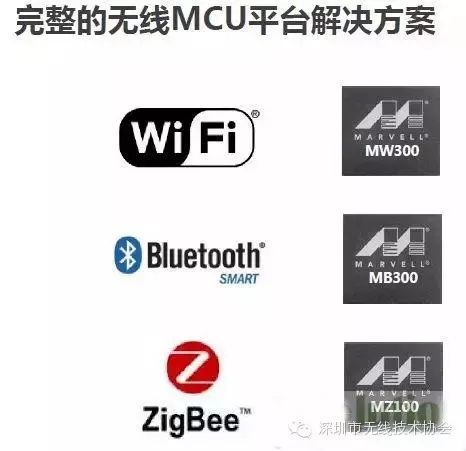
Marvell’s comprehensive wireless MCU platform covers WiFi, Bluetooth, Zigbee, providing high integration, significantly improving performance, reducing power consumption, and lowering overall material costs. Coupled with the software development platform Marvell EZ-Connect, it allows developers to achieve application development in just a few days.
In June 2014, Marvell launched a comprehensive wireless MCU platform for IoT applications: MW300 Wi-Fi microcontroller, MB300 Bluetooth microcontroller, and MZ100 ZigBee microcontroller. Based on integrating MCU, RF transceiver, network/wireless protocol stack on a single chip, it also integrates software development kits and debugging tools, providing multi-layer security protection.
Among them, MW300 Wi-Fi microcontroller supports 802.11n Wi-Fi, a single-chip SoC with a fully functional microcontroller, specifically optimized for low power consumption, achieving deep low power states while reducing power consumption during normal operation, suitable for various battery-powered application scenarios; MB300 Bluetooth microcontroller supports dual-mode Bluetooth 4.1, a true single-chip SoC integrating a microcontroller, allowing classic and smart Bluetooth to coexist, with built-in voice functionality supporting high-resolution ADC and direct connection to microphones; MZ100 ZigBee microcontroller supports 802.15.4/ZigBee, integrating a microcontroller SoC, providing coexistence of Wi-Fi and Bluetooth, easy to connect with sensors, starters, and other components, reducing external components and PCB area. Marvell EZ-Connect software platform supports this latest wireless product series, significantly reducing development time.
Application Scenarios: Wearable devices, home automation, home security, personal health care, smart appliances, accessories and remote controls, automotive, lighting, industrial internet, etc. The three chips are suitable for different application scenarios: MW300 Wi-Fi microcontroller is mainly suitable for long-term connections of home appliances like refrigerators and air conditioners in smart homes; MB300 Bluetooth microcontroller is suitable for “interaction” between devices; MZ100 ZigBee microcontroller has obvious advantages in smart lighting and multi-terminal interconnection.
2. Integrated MCU and wireless functionality modules
1. Microchip RN4020 Bluetooth smart module can connect to host MCU or operate independently
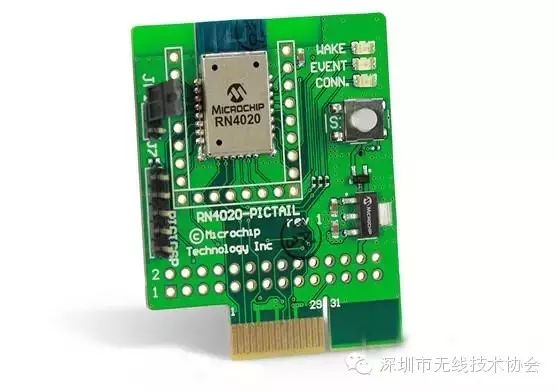
Supports the latest Bluetooth 4.1, featuring low power consumption, long transmission distance, and compact size. It can connect to any microcontroller with a UART interface (including hundreds of PIC®MCU), or it can operate independently without a MCU.
Shortly after acquiring Roving Networks, Microchip quickly launched the WiFi wireless module RN-171 and RN-131 in September 2012, which can connect to any PICMCU. In 2013, it successively released MRF24WG0MA/MBWiFi modules, integrating wireless modules and PIC MCU, supporting low data rate Wi-Fi sensor networks, home automation, building automation, and consumer electronics applications.
In June 2014, Microchip launched the Bluetooth 4.1 low-power module RN4020, providing a transmission power of 7 dBm and a receiving sensitivity of -92.5 dBm with a built-in PCB antenna, enabling effective working distance over 100 meters, with a very compact size of only 11.5×19.5×2.5mm. RN4020 is an onboard protocol stack module that can connect to any microcontroller with a UART interface (including hundreds of PIC®MCU), or it can operate independently for basic data collection and communication, such as in beacons or sensors. The standalone mode is based on Microchip‘s unique non-compiled script, using a simple ASCII command interface for module configuration without tools or compilation.
Application Scenarios: Suitable for home automation and household appliances, lighting applications, medical devices, wearable devices, toys, tags, watch bands, and remote control devices, systems based on pulse and proximity sensors, and even various industrial applications.
2. Atmel SmartConnect SAM W23 module merges wireless and control advantages
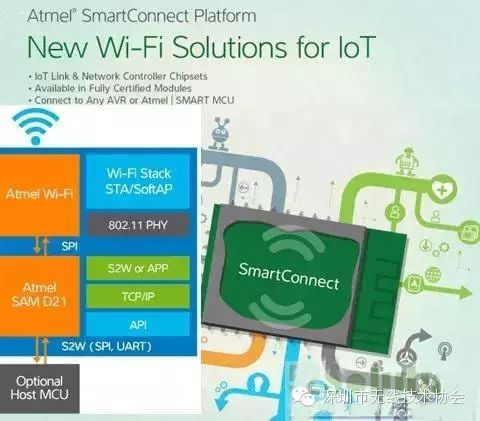
Integrates WiFi connectivity, network protocols, security, etc., along with Atmel‘s ARM Cortex M0+ microcontroller technology, allowing the SAM W23 platform to be used as a standalone system or as a functional expansion solution, thereby achieving WiFi connectivity in current designs.
Given the strong offensive of the IoT market, Atmel launched the new MCU brand —Atmel SMART and the SmartConnect SAM W23 module in June 2014, which is based on Atmel‘s ultra-low power WiFi system-on-chip, achieving a combination of low-power MCU and Wi-Fi solutions. The SAM W23 module integrates WiFi functionality, allowing designers to focus on enhancing product functionality without needing to learn the WiFi stack. The SAM W23 module is an ideal solution for designers seeking to integrate WiFi connectivity with IEEE802.11, RTOS, IP stacks, or RF, and it also provides application and security protocols (such as TLS), integrated network services (TCP/IP stack), and standard real-time operating systems (RTOS), all of which can be implemented through simple serial host interfaces (SPI, UART) in Atmel Studio 6‘s integrated development platform (IDP).
Application Scenarios: Suitable for a wide range of residential, medical, industrial, consumer, smart energy, and wearable device markets.
3. Freescale Kinetis W series wireless modules have advantages in Zigbee

The Kinetis KW2X wireless module reduces power consumption and integrates advanced security features typically found in high-end processors, supporting advanced encryption methods such as key generation, secure storage, and tamper detection, providing 512KB flash memory and 64KB RAM, as well as 64K FlexMemory, allowing users to use flexibly, paired with Kinetis development tools to further accelerate product development.
MCU is Freescale’s strategic focus, and in the IoT era, Freescale is also planning for the IoT by integrating MCU and Zigbee wireless technology and RF transceiver, launching a series of integrated MCU—Kinetis W series, providing flexible product choices for 2.4GHZ Zigbee/ IEEE 802.15.4 applications and below 1GHZ IEEE 802.15.4.
In late 2013, Freescale launched the Kinetis series KW2x wireless MCU. KW2x is a low-power, compact integrated device, composed of a high-performance compatible IEEE 802.15.4 2.4 GHz wireless transceiver and a powerful ARM Cortex-M4 MCU system, equipped with data connections and high-precision mixed-signal analog peripherals.
Application Scenarios: KW2x wireless MCU is mainly used in smart energy, home/building automation, healthcare, home entertainment, etc., with typical applications including home networks composed of meters, gateways, home displays, and interconnected devices; connected building control and home automation applications with lighting control, HVAC, and security functions.
4. NXP JN516x wireless MCU module targeting smart home
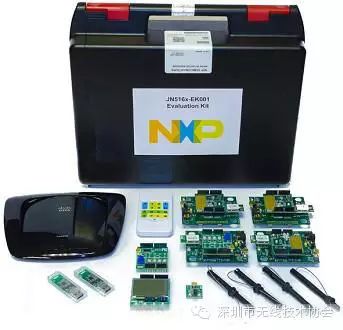
For smart lighting, residential automation, and energy management applications, the JN516x wireless MCU module series combines the best combination of price/performance, on-chip memory, ultra-low power, and software stack options. In particular, NXP has also launched the LightPRO smart lighting system module, allowing the construction of smart lighting networks with up to 500 nodes, perfectly covering commercial and public lighting applications.
Since 2011, NXP has been focusing on smart lighting as a breakthrough to attack the IoT. Initially, its LPC series MCU did not integrate wireless functions. In early 2013, NXP launched the JN516x series wireless MCU modules for IoT, including JN5161, JN5164, or JN5168, which integrated wireless functions.
The module is equipped with a high-performance 32-bit RISC processor, embedded Flash and E2PROM, improving code efficiency through variable-width instructions, multi-level instruction pipelines, low power consumption, and programmable clock speeds. At the same time, it has a wireless transceiver that complies with the IEEE802.15.4 2.4GHz standard and a rich set of analog and digital peripherals. Coupled with ultra-low operating current and low-power sleep characteristics, it can power devices using button batteries and extend battery life.
Application Scenarios: In conjunction with NXP’s commercial development and evaluation kits, developers can develop applications in smart lighting, asset management, building control, smart energy, home automation, remote control, and other fields. Based on JN516x, many successful commercial products have been developed, such as Cherry‘s wireless energy harvesting switch, which can send 8 wireless data packets with a single press of the switch, thus achieving the function of switching or dimming bulbs.
5. STMicroelectronics SPWF series micro smart WiFi modules low power small size
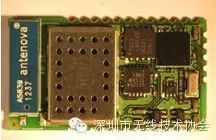
The SPWF series micro smart WiFi modules feature low power consumption and small size, allowing for easy plug-and-play integration with IoT devices and standalone 802.11 b/g/n devices.
Aiming at IoT opportunities, STMicroelectronics not only provides a range of low-power, low-cost ARM Cortex-M processor series STM32 MCU, but also integrates WiFi technology, launching the SPWF series micro smart WiFi modules. The PWF01S WIFI module is configured as a single-chip 802.11 transceiver, featuring an integrated PA and STM32 ARM Cortex-M3 32-bit MCU, offering 1.5MB and 512KB flash memory options as well as 64 KB RAM, supporting a wide range of GPIO, including clocks and regulators, facilitating easy plug-and-play integration with IoT devices and standalone 802.11 b/g/n devices.
In addition, STMicroelectronics has expanded its product line, launching integrated 32-bit Cortex-M core MCU and 2.4GHz RF transceivers, Bluetooth technology, and plans to introduce wireless MCU solutions supporting next-generation multi-communication protocols to overcome various IoT device development challenges.
Application Scenarios: Products can be used in smart appliances, industrial control and data acquisition, home automation and security systems, wireless sensors, cable replacement, medical devices, and machine-to-machine communications.
6. MXCHIP EMW3161 IoT WIFI module
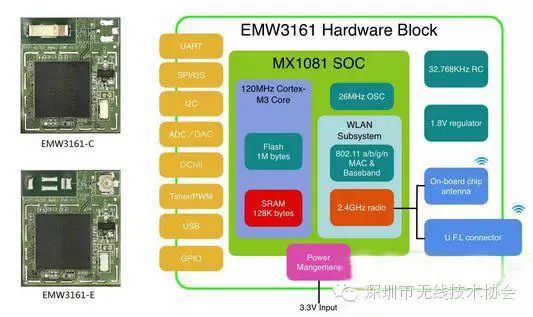
EMW3161 is an ultra-small, ultra-low-power embedded Wi-Fi module based on MX1081. MX1081 is a highly integrated Wi-Fi microcontroller, integrating IEEE 802.11 MAC, baseband, RF, and a microcontroller core that can run Wi-Fi network protocol stacks and applications. EMW3161 has built-in 1M bytes of flash memory, 128K bytes of RAM, and rich peripherals.
With the mxchipWNet embedded Wi-Fi firmware, users can easily and quickly add Wi-Fi network communication capabilities to embedded devices, for example, using mxchipWNet-DTU serial transparent transmission firmware, which can immediately add wireless network functionality to your serial devices. This shortens the development cycle and achieves rapid market entry. Users can also use mxchipWNet software libraries to develop various embedded Wi-Fi applications directly on the module, further reducing costs and product size.
Application Scenarios:
★ Building automation/security control systems
★ Smart appliances
★ Medical and personal health systems
★ Mobile point of sale systems (POS)
★ Automotive electronics
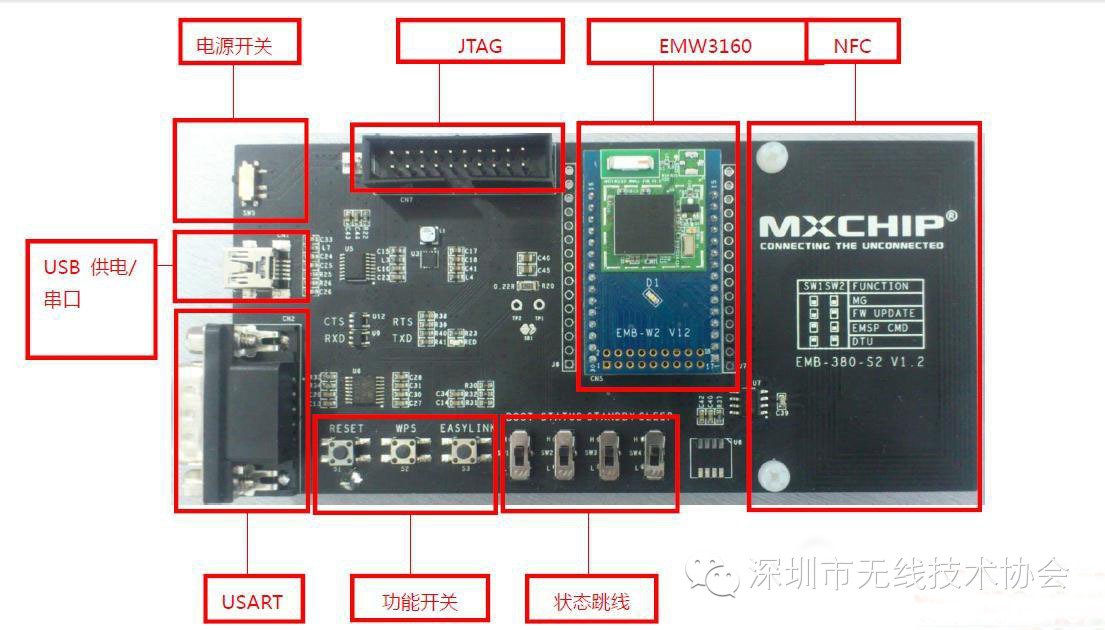
Development board physical picture
3. Integrated embedded processors and wireless single-chip SOC
1. Broadcom WICED platform WiFi BCM4390+ Bluetooth BCM2073X high integration low power
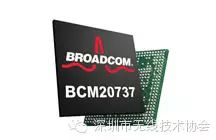
As a leading semiconductor manufacturer, Broadcom’s advantages in the wireless field are evident, with high chip integration and significantly reduced power consumption. The WICED platform provides a one-stop diversified application, allowing customers to perform different software development for different applications.
In June 2013, Broadcom launched the single-chip WiFi solution –BCM4390, which is also part of Broadcom’s embedded device Internet wireless connection WICED product portfolio. The BCM4390 SoC complies with IEEE 802.11b/g/n standards, integrating PA and LNA|2.4GHZ RF transceivers, general asynchronous transceivers (UART), etc., flexibly implementing real-time operating systems (RTOS), network protocol stacks in application processors, laying a foundation for low-power, high-performance, and interoperable wireless connection functions, helping microcontroller embedded devices reduce power consumption and costs.
In addition to WiFi solutions, WICED continues to evolve, in June 2014, Broadcom launched the WICED Smart Bluetooth SoC chip —BCM20737. The new product has three main features: supports Bluetooth Smart standard (Bluetooth 4.0 and above), iBeacon technology, which can accelerate proximity detection speed; supports A4WP wireless charging; supports RSA 4000 bit encryption and decryption, providing encryption for data transmission between products.
Application Scenarios: BCM4390 is suitable for 8 and 16-bit microcontroller systems, helping low-power, battery-powered devices achieve WiFi connectivity. BCM4390 initially supports applications including fitness, health, security, and automation. The innovative technology based on the WICED platform can help OEM achieve connectivity on smaller household appliances using a single chip, including slow cookers, lamps, etc. BCM20737 is suitable for toys, medical devices, remote control, and other practical application needs, while support for Apple iBeacon technology gives it an advantage in area-limited and device detection.
2. Qualcomm Atheros low-power single-chip WiFi platform QCA4002/4004

The QCA4002/QCA4004 adopts low-power technology, such as dynamic power adjustment Green TX function, allowing devices to reduce transmission power by up to 1/2 when near other devices or access points, paired with sleep modes to achieve more energy-efficient communication. Moreover, regardless of whether users develop high-end or low-end applications, the platform can meet the needs.
In September 2013, Qualcomm Atheros launched the low-power single-chip WiFi platform QCA4002/4004, aiming to layout the rapidly developing IoT market, which is also a single-chip platform based on 802.11n specifically for IoT applications. QCA4002/4004 not only uses a single-chip processor and memory in chip design, eliminating the need for other MCU products, but also incorporates IP stacks, software middleware architecture AllJoyn, and complete network services to assist customers in adding low-power WiFi functionality to any product at the lowest development cost. Due to its single-chip design, both platforms have very low power consumption and can operate in both 2.4G and 5G frequency bands.
The difference between QCA4002 and QCA4004 is that QCA4002 is a subsystem that can be used for some applications that require powerful MCU or high memory, achieved by pairing with various MCU or memory, etc., while QCA4004 is used for some lower-end applications, where the built-in CPU can independently implement many applications.
Application Scenarios: QCA4002/4004 can be applied to various new devices in homes and offices, including washing machines, air conditioning equipment, water heaters, and consumer electronics, as well as sensors and smart sockets for home lighting, security, and automation systems. Currently, Haier has adopted QCA4004 in its washing machines/dryers and air conditioning equipment.
3. MTK single-chip wifi soc MT7688/MT7681 designed for smart homes
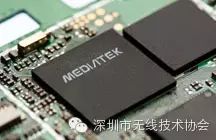
MTK claims that these two new products are low power consumption, supporting the Smart Connection smartphone application, enabling network connectivity for lighting fixtures, smart TVs, smart locks, and other appliances.
When mentioning MTK, people often think of mobile processors, but in fact, MTK is also actively advancing in the IoT field. At the Taipei Computer Show in June 2014, MTK launched two smart home system wifi chips MT7688 and MT7681.
MT7688 adopts a Linux system, supports 802.11n, built-in MIPS24KEc/580MHz processor, 256MB memory, and AES128/256 encryption engine, capable of handling more complex or data-intensive smart home devices, such as IP projectors and home monitoring systems. MT7681 is primarily aimed at smaller devices such as bulbs, door locks, sockets, etc., supporting 802.11n, easily designing network services for embedded devices, integrating power management units, low-frequency amplifiers, RF switches, all functions integrated in a 40 pin 5*5 mm package.
Application Scenarios: MT7688 is suitable for developing more complex smart home devices, while MT7681 is suitable for the application development of smaller devices such as bulbs, door locks, and sockets.
4. STMicroelectronics single-chip Bluetooth 4.0 chip BlueNRG processor high energy efficiency

BlueNRG features the best current consumption in its class, excellent wireless link performance, and an on-chip non-volatile memory chip, not only consuming less power but also being smaller, making it more suitable for wearable devices.In 2013, ST launched the integrated Cortex M0 and Bluetooth function BlueNRG processor chip, with built-in dedicated RF interface, processor, and Bluetooth firmware, supporting Bluetooth 4.0 standard. BlueNRG allows designers to flexibly choose their preferred MCU and equip it with the Bluetooth Low-Energy protocol stack running on external application processors. The on-chip non-volatile memory easily facilitates firmware upgrades, ensuring applications remain compatible with the latest Bluetooth standards.
Application Scenarios: The new chip can achieve longer battery life and smaller, lighter battery sizes for various wireless smart application accessories such as fitness wristbands, smart glasses, or interactive clothing.
Source: I Love Solutions Network
Shenzhen Near-range Wireless Technology Application Association (WeChat ID wxjs0755) is a comprehensive service platform specializing in wireless technologies (Bluetooth, WIFI, NFC, RFID, etc.), wireless applications (smart homes, smart wearable devices, smart terminals, wireless transmission, wireless payment), currently with over 200 members, including more than 20 listed companies. The association aims to create a wireless technology valley and the China (Shenzhen) wireless technology application trend forum.
The China (Shenzhen) Wireless Technology Application Trend Forum will be held in April at the Shenzhen Convention and Exhibition Center, with the theme “Wireless Technology Leading Smart Life”, highlighting foresight, authority, internationality, and practicality, gathering government leaders, industry experts and scholars, operators, product providers, application developers and content service providers, investors, and news media from various sectors to dialogue with domestic and foreign chip giants such as Qualcomm, Intel, MTK, Broadcom, CSR, TI, Huawei HiSilicon, etc., discussing the development trends of wireless technology applications in smart homes, smart wearable devices, smart terminals, and other products. At the same time, the “China Wind Top10 ● 2015 Annual Top Ten Fashion Wireless Technology Application Products” will be released, and a special “Wireless Technology Application Product Exhibition” will be opened in Hall 4 of the China Electronics Show.
For more information, please follow the WeChat public account of Shenzhen Near-range Wireless Technology Application Association: wxjs0755
To learn more about the “China (Shenzhen) Wireless Technology Application Trend Forum”, please click on “Read Original” below!
